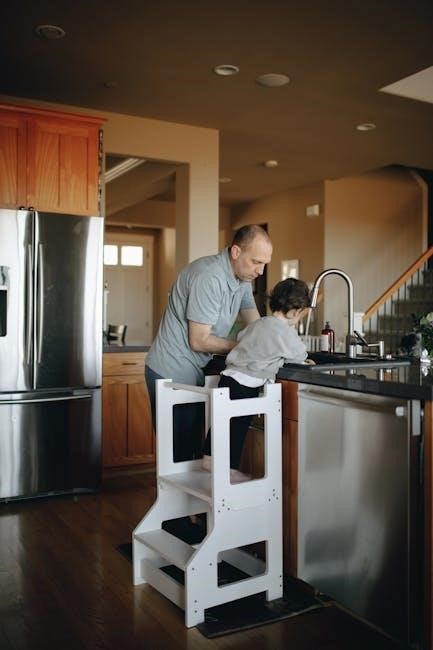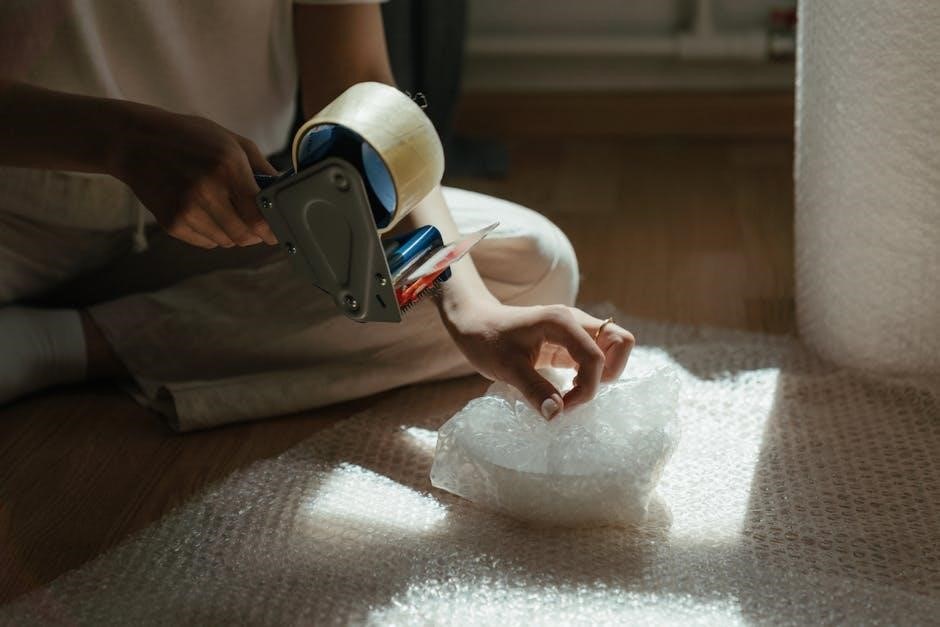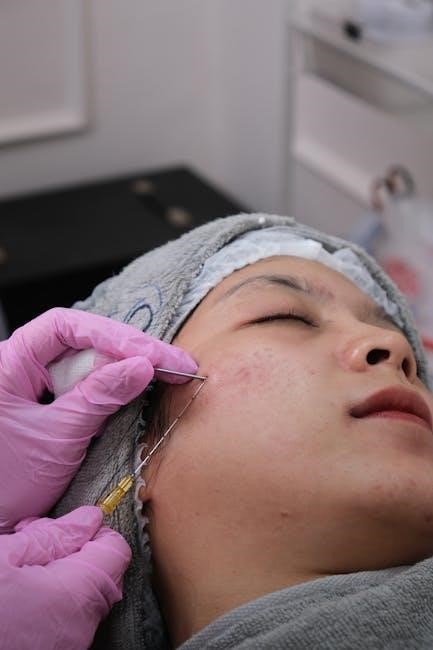Immediate Post-Microneedling Care
Hydrate the skin immediately after treatment to prevent dryness. Use gentle, fragrance-free products like Vaseline or Cicalfate for the first 24 hours. Avoid harsh cleansers or exfoliants.
Starting Day 2, cleanse with a mild soap-free cleanser to maintain skin balance. Monitor for redness or irritation, and avoid touching the treated area to prevent infection.
1.1. Day 1-2: Essential Hydration and Protection
During the first 48 hours post-microneedling, hydration and protection are critical for optimal healing. Apply Vaseline or Cicalfate immediately after treatment to soothe and moisturize the skin, ensuring it doesn’t dry out. Avoid using harsh cleansers or exfoliants during this period, as they can irritate the sensitive skin. Instead, gently cleanse with lukewarm water and a mild, fragrance-free cleanser starting on Day 2.
Protect your skin from sun exposure by applying a broad-spectrum sunscreen with SPF 30 or higher. Avoid touching the treated area to prevent infection and refrain from wearing makeup for the first 24-48 hours. Keep your skincare routine simple and avoid any products containing retinoids, exfoliants, or irritants. This period is about allowing your skin to recover and rebuild, so prioritize hydration and gentle care to support the healing process.
1.2. Day 3-5: Gentle Cleansing and Monitoring
From Day 3 to Day 5, continue with gentle cleansing to support your skin’s recovery. Use a mild, soap-free cleanser like Cetaphil or Cerave to maintain cleanliness without irritation. Avoid scrubbing or using exfoliants, as your skin may still be sensitive. Gently massage with lukewarm water to remove serum or dried blood, but refrain from using washcloths or brushes that could scratch the skin.
Monitor your skin for any signs of complications, such as increased redness, swelling, or discharge. If you notice flaky skin forming, do not pick at it; instead, let it shed naturally. Avoid touching the treated area to minimize the risk of infection. Keep your skincare routine simple, avoiding retinoids, benzoyl peroxide, and other irritants. This period is crucial for healing, so focus on maintaining a clean, hydrated, and protected environment for your skin to recover effectively.
1.3. Day 6-7: Transitioning to Normal Skincare
By Day 6-7, your skin should be mostly healed, allowing you to gradually reintroduce your normal skincare routine. Start by incorporating gentle, non-irritating products, ensuring they are fragrance-free and suitable for sensitive skin. Avoid harsh exfoliants or retinoids for at least one week post-treatment. Instead, focus on hydrating your skin with a moisturizer to maintain its balance and promote further healing.
Resume your regular cleanser if it is gentle and fragrance-free, but continue to avoid scrubbing or using brushes that could irritate the skin. Light, mineral-based makeup can now be used if needed, but opt for clean tools to minimize the risk of infection. Avoid heavy or oily products that may clog pores. Monitor your skin’s response to each product and adjust as needed to ensure continued healing and comfort.

Lifestyle Adjustments After Microneedling
Post-microneedling, avoid strenuous activities, hot showers, and direct sun exposure to support healing. Maintain a balanced lifestyle, including proper hydration and nutrition, to optimize skin recovery and results.
2.1. Avoiding Exercise and Strenuous Activities
It is crucial to avoid exercise and strenuous activities for at least 24 to 48 hours after microneedling. This allows the skin to heal without irritation or excessive sweat, which can lead to complications. Sweat can introduce bacteria to the treated area, increasing the risk of infection. Additionally, vigorous movements may dislodge the micro-injuries created during the procedure, potentially affecting results. Gentle stretching or low-intensity activities can be gradually incorporated after the initial healing phase, typically around Day 3 or 4. However, consult your practitioner for personalized advice, as recovery times may vary depending on treatment intensity and individual skin response.
2.2. Avoiding Hot Showers or Baths
Avoid hot showers or baths for the first few days after microneedling to prevent irritation and dryness. Hot water can strip the skin of its natural oils, delaying healing. Instead, use lukewarm water for cleansing. Gently massage the face with lukewarm water to remove serum or dried blood, avoiding scrubbing or harsh cleansers. This helps maintain hydration and prevents infection. Excessive heat can also cause redness or discomfort, so keep water temperature mild during this period. Pat dry the skin gently with a clean towel instead of rubbing. By minimizing heat exposure, you protect the micro-injuries created during the procedure, allowing the skin to heal smoothly. This precaution is especially important during the initial healing phase, typically the first 48 hours, when the skin is most sensitive.
2.3. Minimizing Sun Exposure
Minimizing sun exposure is crucial after microneedling to protect the sensitive skin and prevent complications. UV rays can cause sunburn, hyperpigmentation, or delay healing. Avoid direct sunlight for at least 24-48 hours post-treatment. When going outside, wear protective clothing like wide-brimmed hats and use sunscreen with SPF 30 or higher. Reapply sunscreen every 2 hours if exposed to the sun. This ensures the skin remains protected and promotes optimal healing. Avoid tanning beds and prolonged outdoor activities during peak sun hours. Sunburned skin cannot undergo microneedling, so preventing sun damage is essential for maintaining treatment results. By shielding your skin from harmful UV rays, you support the healing process and achieve better outcomes from the procedure. Proper sun protection is a key component of post-microneedling care, ensuring your skin recovers smoothly and effectively.

Skincare Routine Post-Microneedling
Keep your routine simple with gentle, fragrance-free cleansers like Cetaphil or Cerave. Avoid retinoids, exfoliants, and irritants for 5-7 days. Moisturize regularly to support skin hydration and healing.
3.1. Using Gentle, Fragrance-Free Cleansers
After microneedling, it’s crucial to use gentle, fragrance-free cleansers to avoid irritating the sensitive skin. Products like Cetaphil, Cerave, or La Roche Posay are highly recommended for the first week.
Avoid harsh exfoliants or astringents, as they can disrupt the healing process. Instead, opt for soap-free, non-comedogenic cleansers that maintain the skin’s natural pH balance without stripping it of moisture.
Gently massage the cleanser onto damp skin with clean hands, focusing on areas treated during the procedure. Rinse thoroughly with lukewarm water and pat dry with a clean towel to prevent friction.
Refrain from using washcloths or brushes during the initial healing phase, as they may cause micro-tears in the skin. Stick to lightweight, hypoallergenic formulas to support recovery and minimize irritation.
3.2. Avoiding Retinoids, Exfoliants, and Irritants
After microneedling, it’s essential to avoid retinoids, exfoliants, and other irritants for at least 3-5 days. These products can disrupt the healing process and cause unnecessary irritation.
Retinoids, hydroquinone, and benzoyl peroxide should be avoided, as they can interfere with the skin’s natural repair mechanisms. Similarly, exfoliants like alpha-hydroxy acids (AHAs) or beta-hydroxy acids (BHAs) should be postponed until the skin has fully healed.
Steer clear of harsh skincare products containing artificial fragrances, dyes, or alcohol, as they can strip the skin of moisture and prolong recovery. Instead, focus on using gentle, hydrating products to support the skin’s natural barrier function.
Your skincare professional may recommend specific products to use during this period. Always follow their guidance to ensure optimal healing and minimize the risk of complications.
3.3. Importance of Moisturizing
Maintaining proper hydration is crucial after microneedling to support the skin’s healing process. Moisturizing helps soothe irritation, reduces redness, and prevents dryness or flakiness.
Use a gentle, fragrance-free, and hypoallergenic moisturizer to avoid irritating the sensitive skin. Avoid heavy or occlusive products like petroleum jelly, as they can clog pores or interfere with the healing process.
Apply moisturizer liberally throughout the day, especially after cleansing, to keep the skin hydrated and comfortable. Consistent hydration promotes a faster recovery and minimizes the risk of complications.
Consult your skincare professional for recommendations on the best moisturizers to use during your recovery period. Proper moisturizing plays a key role in achieving optimal results from your microneedling treatment.

Makeup and Microneedling Aftercare
Avoid makeup for the first 24-48 hours post-treatment to allow the skin to heal. Use clean makeup tools and mineral-based products when resuming to minimize irritation and infection risks.
4.1. When to Resume Makeup Use
Generally, makeup can be resumed 24 to 48 hours after microneedling, allowing the skin to heal and minimize infection risks. During this period, the skin is highly sensitive, and makeup could introduce bacteria or clog pores, potentially leading to complications. Once cleared to use makeup, opting for mineral-based products is advisable, as they are typically gentler and less likely to cause irritation compared to regular makeup. It’s crucial to ensure all makeup tools, such as brushes and sponges, are thoroughly cleaned before use to maintain hygiene. Application should be gentle, avoiding heavy coverage to let the skin breathe and continue healing. Resuming normal makeup routines should be done cautiously, possibly starting with hypoallergenic or fragrance-free products to accommodate the skin’s sensitive state. Monitoring for signs of irritation, such as redness or breakouts, is essential to determine if the skin is ready for makeup. Patience and careful adherence to these guidelines will help support the healing process and prevent any setbacks.
4.2. Best Practices for Makeup Application
When resuming makeup after microneedling, prioritize gentle application to avoid irritating the skin. Use clean, hypoallergenic, and fragrance-free products to minimize the risk of adverse reactions. Mineral-based makeup is ideal, as it is less likely to clog pores or cause irritation. Apply makeup sparingly, focusing on problem areas rather than full coverage, to allow the skin to breathe and continue healing. Avoid heavy or oil-based products, as they may slow down the recovery process. Ensure all makeup tools, such as brushes and sponges, are thoroughly sanitized before use to prevent infection. Gently blend products, avoiding harsh rubbing or pulling on the skin. If possible, opt for a light, natural look to maintain skin health. Remember, makeup should complement the healing process, not hinder it. Always consult your skincare professional for personalized advice tailored to your specific needs.
4.3. Using Clean Makeup Brushes and Tools
Proper hygiene of makeup brushes and tools is crucial after microneedling to prevent infection and promote healing. Wash all brushes and sponges with mild soap and warm water before and after use. Sanitize tools with a makeup brush cleaner or a solution of 70% isopropyl alcohol. Ensure tools are completely dry before using them on your face to avoid bacterial growth. Replace any disposable applicators or sponges after each use to maintain cleanliness. Regularly cleaning your tools reduces the risk of introducing bacteria into the treated skin, which can lead to complications. Always store makeup tools in a clean, dry place to prevent contamination. By maintaining clean makeup tools, you protect your skin and support the healing process post-microneedling. Cleanliness should be a top priority during your recovery to achieve optimal results and minimize potential side effects.

Supplements and Nutrition for Healing
Supplements like Omega-3, Zinc, and Glucosamine support skin repair. Avoid anti-inflammatory medications to prevent delayed healing. Stay hydrated and consume a nutrient-rich diet to promote recovery and collagen production.
5.1. Omega-3, Zinc, and Glucosamine Supplements
Omega-3 fatty acids, Zinc, and Glucosamine are essential for skin repair and collagen production. Omega-3 reduces inflammation, while Zinc supports immune function and tissue healing. Glucosamine promotes skin elasticity and hydration.
These supplements enhance the body’s natural healing process, minimizing downtime after microneedling. Ensure proper dosages and consult a healthcare provider before starting any regimen. A balanced diet rich in these nutrients also supports recovery.
5.2. Avoiding Anti-Inflammatory Medications
Avoiding anti-inflammatory medications after microneedling is crucial to support the skin’s natural healing process. These medications can suppress the body’s inflammatory response, which is essential for collagen synthesis and tissue repair. Avoid NSAIDs, aspirin, and corticosteroids unless directed by a healthcare professional.
Natural alternatives like acetaminophen can be used for mild discomfort. Always consult your provider before stopping or starting any medication. Delaying or reducing inflammation may hinder the treatment’s effectiveness and prolong recovery time. Prioritize your skin’s ability to heal naturally to achieve optimal results from microneedling. Adhering to this guideline ensures proper wound healing and maximizes the benefits of the procedure. Professional advice is key to avoiding complications and ensuring a smooth recovery.
5.3. Hydration and Nutrient-Rich Diets
Hydration is vital for skin healing post-microneedling. Drink plenty of water to keep your skin hydrated and support collagen production. A nutrient-rich diet enhances recovery by providing essential vitamins and minerals.
Incorporate foods high in vitamins A, C, and E, as well as zinc and omega-3 fatty acids, to promote healing and reduce inflammation. Leafy greens, berries, nuts, and fatty fish are excellent choices. Avoid alcohol and caffeine, as they can dehydrate the skin and slow recovery.
A balanced diet ensures your skin receives the necessary building blocks for regeneration. Proper hydration and nutrition help maintain skin elasticity and reduce the risk of complications. Focus on whole, unprocessed foods to optimize your results and support your skin’s natural repair process.

Sun Protection After Microneedling
Protect your skin from sun exposure after microneedling by using sunscreen with SPF 30 or higher. Reapply every two hours and wear protective hats and clothing to shield sensitive skin.
6.1. Using Sunscreen with SPF 30 or Higher
After microneedling, your skin is highly sensitive, making sun protection crucial. Always use broad-spectrum sunscreen with SPF 30 or higher to prevent damage and promote healing. Apply it 15-20 minutes before sun exposure and reapply every 2 hours, especially after sweating or swimming. Physical sunscreens, like those containing zinc oxide, are ideal as they create a protective barrier. Avoid chemical sunscreens if your skin is sensitive post-procedure. Consistent use helps prevent hyperpigmentation and ensures optimal results from your treatment.
6.2. Wearing Protective Hats and Clothing
Protecting your skin from the sun is essential after microneedling, and wearing protective hats and clothing is a key part of this. Choose a wide-brimmed hat to shield your face and neck from direct sunlight. Opt for tightly woven fabrics or clothing with a UPF (Ultraviolet Protection Factor) rating of 30 or higher, as these block 97% of UV rays. Loose-fitting clothes made from natural fibers like cotton or linen are recommended, as they allow skin to breathe while still offering protection. Avoid peak sun hours (10 AM to 4 PM) when possible. By combining protective clothing with sunscreen, you create a comprehensive defense against UV damage, promoting healing and preventing complications like hyperpigmentation or prolonged redness.
6.3. Reapplying Sunscreen Every 2 Hours
Reapplying sunscreen every 2 hours is crucial after microneedling to protect sensitive skin from UV damage. Use a broad-spectrum sunscreen with SPF 30 or higher, applying it generously. Even on cloudy days, UV rays can penetrate, so consistency is key. If swimming or sweating, reapply immediately. Pair with protective clothing and hats for enhanced defense. This routine helps prevent complications like hyperpigmentation, ensuring optimal healing and results.